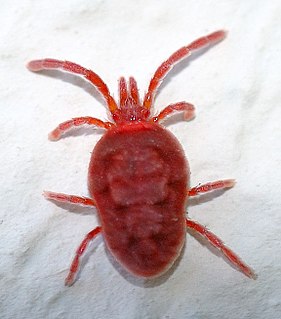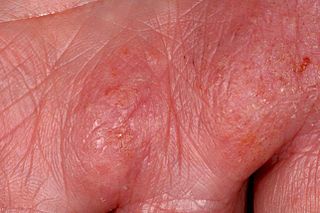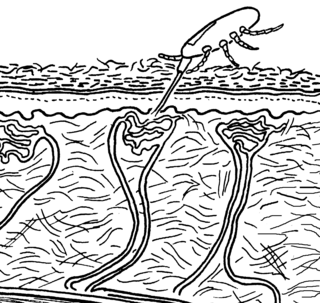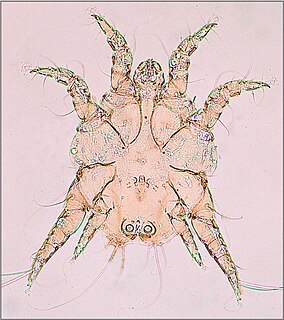
Mites are small arachnids.

Mange is a type of skin disease caused by parasitic mites. Because mites also infect plants, birds, and reptiles, the term "mange" or colloquially "the mange", suggesting poor condition of the hairy coat due to the infection, is sometimes reserved only for pathological mite-infestation of nonhuman mammals. Thus, mange includes mite-associated skin disease in domestic animals, in livestock, and in wild animals. Since mites belong to the arachnid subclass Acari, another term for mite infestation is acariasis.
Skin disorders are among the most common health problems in dogs, and have many causes. The condition of a dog's skin and coat are also an important indicator of its general health. Skin disorders of dogs vary from acute, self-limiting problems to chronic or long-lasting problems requiring life-time treatment. Skin disorders may be primary or secondary in nature, making diagnosis complicated.

Atopic dermatitis (AD), also known as atopic eczema, is a long-term type of inflammation of the skin (dermatitis). It results in itchy, red, swollen, and cracked skin. Clear fluid may come from the affected areas, which often thickens over time. While the condition may occur at any age, it typically starts in childhood, with changing severity over the years. In children under one year of age, much of the body may be affected. As children get older, the areas on the insides of the knees and elbows are most commonly affected. In adults, the hands and feet are most commonly affected. Scratching the affected areas worsens the symptoms, and those affected have an increased risk of skin infections. Many people with atopic dermatitis develop hay fever or asthma.

Cheyletiella is a genus of mites that live on the skin surface of dogs, cats, and rabbits.
Pityriasis alba is a skin condition, a type of dermatitis, commonly seen in children and young adults as dry, fine-scaled, pale patches on the face. It is self-limiting and usually only requires use of moisturizer creams.

Dermanyssus gallinae is a haematophagous ectoparasite of poultry. It has been implicated as a vector of several major pathogenic diseases. Despite its common names, it has a wide range of hosts including several species of wild birds and mammals, including humans. In both size and appearance, it resembles the northern fowl mite, Ornithonyssus sylviarum.
Ablukast (INN) is a leukotriene antagonist which has applications in the treatment of inflammatory skin conditions.

Dermatitis herpetiformis (DH) is a chronic autoimmune blistering skin condition, characterised by blisters filled with a watery fluid that is intensely itchy. DH is a cutaneous manifestation of coeliac disease. DH is neither related to nor caused by herpes virus: the name means that it is a skin inflammation having an appearance similar to herpes.

Hand eczema presents on the palms and soles, and may sometimes be difficult or impossible to differentiate from atopic dermatitis, allergic contact dermatitis, and psoriasis, which also commonly involve the hands. Even a biopsy of all these conditions may not result in a definitive diagnosis, as all three conditions may demonstrate spongiosis and crusting on the hands.

Guttate psoriasis is a type of psoriasis that presents as small lesions over the upper trunk and proximal extremities; it is found frequently in young adults.
Dogger Bank itch is a cutaneous condition characterized by a long-lasting dermatitis caused by exposure to the sea chervil, Alcyonidium diaphanum, a bryozoan. The disease, common in fishermen who work in the North Sea, has been recognized by the Danish Workman's Compensation Act since 1939.

Gamasoidosis or dermanyssosis is a frequently unrecognized ectoparasitosis and source of growing concern in human medicine, occurring after contact with avian mites which infest canaries, sparrows, starlings, pigeons and poultry and caused by two genera of mites, Ornithonyssus and Dermanyssus. Avian mite species implicated include the red mite, tropical fowl mite and northern fowl mite . Mite dermatitis is also associated with rodents infested with the tropical rat mite, spiny rat mite and house-mouse mite, where the condition is known as rodent mite dermatitis. Urban gamasoidosis is associated with window-sills, ventilation and air-conditioning intakes, rooves and eaves, which serve as shelters for nesting birds. Humans bitten by these mites experience a non-specific dermatitis with intense itching.

Ornithonyssus bacoti is a hematophagous parasite. It feeds on blood and serum from many hosts. O. bacoti can be found and cause disease on rats and wild rodents most commonly, but also small mammals and humans when other hosts are scarce. Outbreaks tend to occur in older, less maintained buildings. The mite, however, can travel several hundred feet on its own if necessary to find a host and can survive for extended periods of time without a host. This, along with the nonspecific dermatitis it causes, can prevent accurate and fast diagnosis of rat mite dermatitis. The scarcity of reports, due in part to misdiagnosis and also the mildness of its symptoms, makes the disease seem less common than it is. The tropical rat mite can be found in both temperate and tropical regions or rather all continents except the Arctic and Antarctic.

Mites that infest and parasitize domestic animals cause disease and loss of production. Mites are small invertebrates, most of which are free living but some are parasitic. Mites are similar to ticks and both comprise the order Acari in the phylum Arthropoda. Mites are highly varied and their classification is complex; a simple grouping is used in this introductory article. Vernacular terms to describe diseases caused by mites include scab, mange, and scabies. Mites and ticks have substantially different biology from, and are classed separately from, insects. Mites of domestic animals cause important types of skin disease, and some mites infest other organs. Diagnosis of mite infestations can be difficult because of the small size of most mites, but understanding how mites are adapted to feed within the structure of the skin is useful.

Cicely Pearl Blair FRCP was a British dermatologist. She discovered that people who had albinism did not get blackheads, as they did not produce melanin, the pigment that makes the comedones black. She also wrote about rashes caused by brown-tailed moth caterpillars. After her retirement, she turned her hand to art and especially silver smithing, fashioning a "chain of office" for the president of the British Association of Dermatologists.
Rodent mite dermatitis is an often unrecognized ectoparasitosis occurring after human contact with haematophagous mesostigmatid mites that infest rodents, such as house mice, rats and hamsters. The condition is associated with the tropical rat mite, spiny rat mite and house mouse mite which opportunistically feed on humans. Rodent mites are capable of surviving for long periods without feeding and travelling long distances when seeking hosts. Cases have been reported in homes, libraries, hospitals and care homes. A similar condition, known as gamasoidosis, is caused by avian mites.

Arthur James Rook FRCP was a leading British dermatologist and the principal author of Rook's Textbook of Dermatology (1968), known as "Rook's", which reached its ninth edition in 2016.

Ian Wesley Whimster MRCPath was a reader of dermatology histopathology at St Thomas' Hospital, London. He gained international recognition for his study of comparative anatomy and experiments with reptiles, particularly observing their colour patterns in relation to their nerve supply. He was part of the medical student team that went into Bergen-Belsen concentration camp in 1945, after it was liberated by British troops. On return, he made numerous contributions to dermatology, including the definition of keratoacanthoma, the distinction between pemphigus and pemphigoid and descriptions of melanocytes and malignant melanoma. He died in a road traffic accident at the age of 55.

Notoedric mange, also referred to as Feline scabies, is a highly contagious skin infestation caused by an ectoparasitic and skin burrowing mite Notoedres cati. N. cati is primarily a parasite of felids, but it can also infest rodents, lagomorphs, and occasionally also dogs and foxes. This skin disease also has zoonotic potential. Infestation is also called acariasis, which refers to a rash that is caused by mites.














